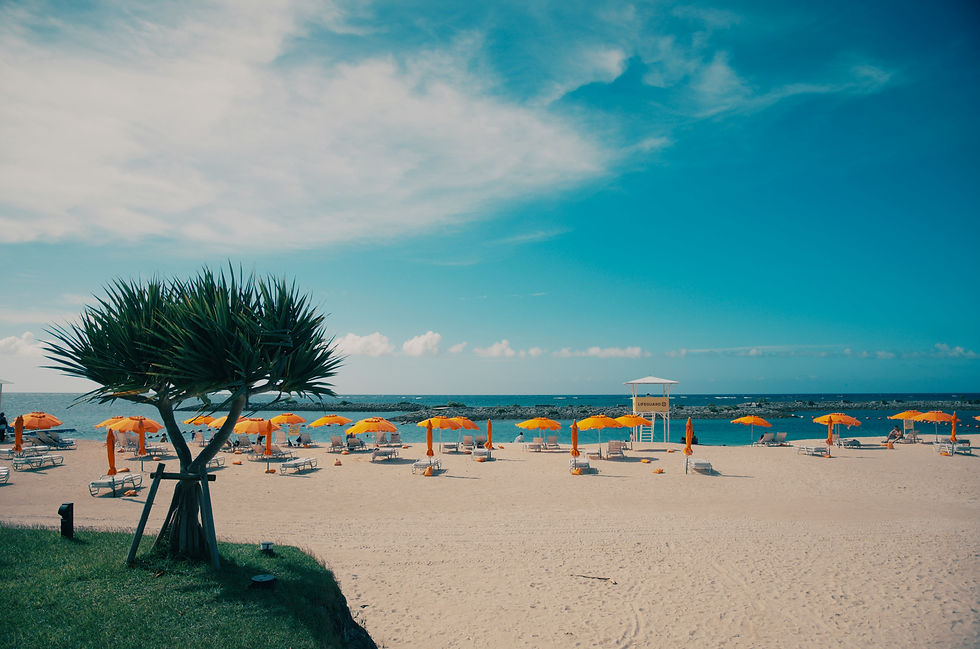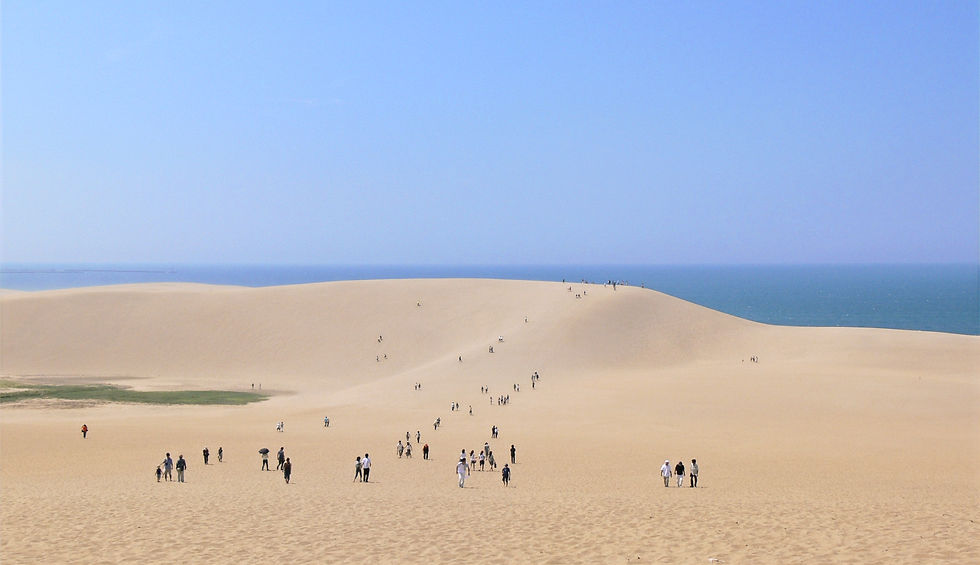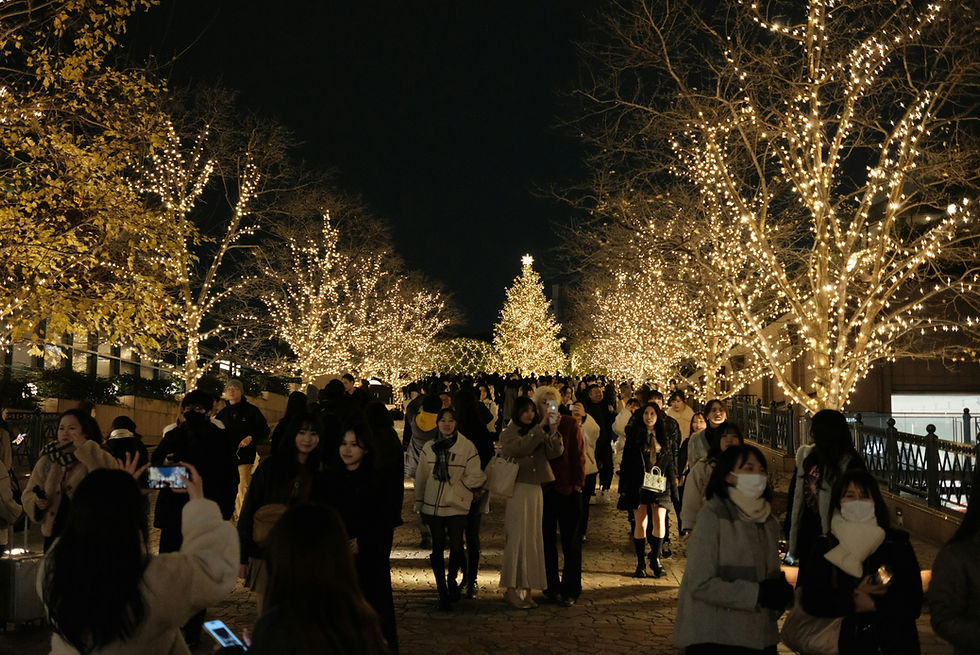Best Beaches in Japan: The Ultimate Guide to Getting your Beach On
- japansophy

- Aug 14
- 8 min read

When you picture Japan, what springs to mind? Perhaps bustling Tokyo crossings, serene Kyoto temples, or the iconic snow-capped peak of Mount Fuji. But here's a little secret that often gets overlooked: Japan is an archipelago, boasting the world's sixth longest coastline, stretching to over 30,000 kilometers! That's a whole lot of shoreline, and with it comes a dazzling array of beaches just waiting to be discovered.
Forget everything you thought you knew about Japan's landscape for a moment, and let's imagine powdery white sands, crystal-clear turquoise waters, and rugged, dramatic coastlines. From subtropical paradises to surf havens and city escapes, Japan truly has a beach for every kind of adventurer. So, grab your virtual swimsuit, because Japansophy is about to take you on a sun-drenched tour of Japan's best coastal gems!
Where the sand meets the sea: Japan's top beach destinations
With such an extensive coastline, trying to pick the "best" beaches in Japan is like trying to choose your favourite sushi roll – deliciously difficult! But let's take a whistle-stop tour, region by region, to highlight some of the most famous and breathtaking spots.

Okinawa and the Ryukyu Islands: Japan's Tropical Paradise
If you're dreaming of turquoise water, vibrant coral reefs, and a distinctly tropical vibe, then Okinawa and the sprawling Ryukyu island chain are your ultimate destinations. Located far to the south, these islands boast a subtropical climate that allows for a much longer beach season.
Okinawa Main Island: Famous beaches include Emerald Beach in Motobu (near Okinawa Churaumi Aquarium), known for its calm, clear waters, and Manza Beach, offering a range of marine activities against a dramatic cliff backdrop. The entire coastline is dotted with resorts and public beaches.
Ishigaki Island: Part of the Yaeyama Islands, Ishigaki is a true gem. Kabira Bay (while swimming is restricted due to boat traffic, its glass-bottom boat tours are phenomenal) is visually stunning. Yonehara Beach is fantastic for snorkeling right off the shore.
Miyakojima: Known for its impossibly white sand and stunningly clear waters, Miyakojima's Yonaha Maehama Beach is often lauded as one of Japan's most beautiful beaches. Its powdery sand stretches for miles, perfect for long strolls.
Other Ryukyu Islands: Don't forget paradise spots like Kumejima, Iriomote (with its jungle-covered interior and unique Hoshizuna-no-hama or "star sand" beach), and the Kerama Islands (a national park renowned for incredible diving and snorkeling).

A beach with a view in Kagoshima
Kyushu: Volcanic Scenery Meets Sandy Shores
Japan's third-largest island offers a diverse coastal experience, blending volcanic landscapes with beautiful beaches.
Miyazaki Prefecture: Often called "Japan's California" for its surfing culture, Miyazaki boasts long, sandy beaches like Aoshima Beach, famous for its "Devil's Washboard" rock formations and Aoshima Shrine.
Fukuoka Prefecture: While known for its city, Fukuoka also has accessible beaches like Itoshima, popular for its relaxed cafes and scenic spots.
Amakusa Islands (Kumamoto): This chain of islands offers beautiful, relatively untouched beaches and clear waters, perfect for swimming and marine activities, along with stunning sunsets.

Shikoku's beaches see fewer crowds, even in high summer
Shikoku: Remote Beauty and Surfing Spots
The smallest of Japan's four main islands, Shikoku offers rugged natural beauty and a more remote feel, making its beaches often less crowded.
Tokushima Prefecture: Ohama Beach is famous as a nesting site for loggerhead turtles, offering both natural beauty and conservation efforts.
Kochi Prefecture: Irino Coast is a long, beautiful sandy stretch perfect for swimming and relaxing, while Tei Beach is popular for surfing.
Ehime & Kagawa Prefectures: The islands of the Seto Inland Sea, like those near Imabari, have calmer, picturesque beaches. Shodoshima, for example, is a hidden gem of an island with some beautiful beaches that you’ll have almost all to yourself.

Chugoku: Serene Inland Sea and Dramatic Coastlines
The westernmost region of Honshu, Chugoku, offers a mix of the tranquil Seto Inland Sea and the more dramatic Sea of Japan coast.
Okayama Prefecture: The Seto Inland Sea islands have many small, calm beaches perfect for families.
Shimane Prefecture: The Inasa-no-hama Beach near Izumo Grand Shrine is culturally significant and offers beautiful coastal scenery, though perhaps less for swimming.
Tottori Prefecture: While famous for its sand dunes, the Tottori Sand Dunes Beach itself is a wide, open expanse where you can enjoy the unique landscape alongside the sea.

Shirahama beach in Wakayama, famous for its white sand
Kansai: Historic Shores and Lake Biwa
Though known for Kyoto and Osaka, the Kansai region also offers coastal escapes.
Wakayama Prefecture: Shirahama Beach is a popular resort town with distinctive white sand (reportedly imported from Australia in some areas to maintain its pristine look!), offering swimming, sunbathing, and hot springs.
Lake Biwa (Shiga Prefecture): While not a sea beach, Japan's largest freshwater lake boasts numerous sandy shores, like Omimaiko Beach, that offer a refreshing alternative to the humid coastal areas, complete with swimming, barbecues, and watersports.
Suma beach (Hyogo Prefecture): A beautiful stretch of sand close to Kobe and very accessible by train, with views of the Akashi Bridge in front and pine-tree-lined parks behind. The promenade hosts a market from time to time.

The Izu peninsula is popular with holidaymakers from Tokyo
Chubu: Coastal Trails and Surfing
The central region of Honshu, spanning from the Alps to the Pacific, offers diverse coastal experiences.
Shizuoka Prefecture: The Izu Peninsula is a popular weekend getaway from Tokyo, known for its scenic coastlines, hot springs, and numerous beautiful beaches like Shimoda's Shirahama Beach (another white sand beauty) and Tatadohama Beach, popular with surfers.
Niigata Prefecture: The Sea of Japan coast offers beaches like Sado Island's Senkaku Bay, known for its clear waters and rugged cliffs.

The Kanagawa coastline is famous for its surfing spots
Kanto: Tokyo's Nearby Escapes and Surf Spots
For those in and around Tokyo, Kanto offers convenient beach access.
Kanagawa Prefecture: Kamakura Beach (Yuigahama and Zaimokuza) is easily accessible from Tokyo, offering a lively atmosphere, views of Enoshima, and sometimes Mount Fuji on clear days. It's more about the vibe and convenient access than pristine waters. Enoshima itself has popular swimming beaches.
Chiba Prefecture: The Boso Peninsula in Chiba is a mecca for surfers, with beaches like Ichinomiya (which hosted surfing events for the Tokyo Olympics) offering consistent waves.

Matsushima Bay counts as one of Japan's top 3 scenic spots
Tohoku: Rugged Beauty and Recovery
The northern region of Honshu offers a more rugged and dramatic coastline, still recovering in some areas from the 2011 tsunami.
Miyagi Prefecture: Matsushima Bay, while famous for its pine-covered islands, also has small, scenic beaches perfect for kayaking and enjoying the views.
Fukushima Prefecture: Efforts are ongoing to revitalise the beautiful coastlines, with some beaches reopening to the public.

Hokkaido's beaches are worth a visit, even in winter
Hokkaido: Cooler Climates and Unique Shores
Japan's northernmost main island offers a much cooler summer climate, making its beaches a refreshing escape from the humidity further south.
Ishikari Bay (near Sapporo): Popular for day trips from the capital, offering wide sandy stretches.
Shakotan Peninsula: Known for its dramatic cliffs and incredibly clear "Shakotan Blue" waters, particularly at Cape Kamui and Shimamui Coast, which offer stunning views (though less for swimming, more for scenic beauty).
Beach facilities in Japan: convenience and cleanliness
One of the great things about visiting beaches in Japan is the emphasis on cleanliness and convenience. Public beaches, especially popular ones, are generally very well-maintained.
You can typically expect:
Public Restrooms and Changing Facilities: Clean and readily available.
Showers: Often coin-operated, but a blessing after a dip.
Lifeguards: During peak season, many popular beaches will have lifeguards on duty.
Beach Huts (Umi no Ie): These temporary structures pop up during summer, offering shade, rental equipment (umbrellas, chairs, floats), and often food and drinks. They're a fantastic convenience.
Parking: Available at most larger beaches, though it can fill up quickly on busy summer weekends.
Shops and Restaurants: Many beaches will have nearby convenience stores, cafes, or restaurants.
Surfing the Japanese waves
Japan might not be the first place that comes to mind for surfing, but it actually has a thriving surf culture! The Pacific coast, particularly in Chiba, Shizuoka (Izu Peninsula), and Miyazaki, offers consistent waves suitable for various skill levels. Surf shops are plentiful in these areas, offering rentals and lessons. Hokkaido also has some lesser-known, colder-water surf spots. Bear in mind that typhoon season can bring powerful swells, often attracting experienced surfers but posing dangers for beginners.
When to visit Japan's beaches: timing is everything!
Choosing the right time to visit Japanese beaches can make all the difference to your experience.
Peak Season (end of July & August): This is when most beaches are officially "open" for swimming, with lifeguards, beach huts, and full facilities. Water temperatures are at their warmest. However, it's also the hottest and most humid time of year, and beaches (especially popular ones) will be very crowded with domestic tourists.
Okinawa & Southern Islands: Thanks to their subtropical climate, these islands have a much longer beach season, often starting as early as April and extending into October.
Avoid Rainy Season (Tsuyu): Japan's rainy season typically runs from early June to mid-July (though it can vary). While it might not rain all the time, expect higher humidity and more frequent downpours. It's generally not the best time for beach visits unless you're very flexible with your plans.
Typhoon Season (Late August to October): This period carries the risk of typhoons, especially in the southern regions. Typhoons bring strong winds, torrential rain, and, critically for beaches, very strong waves and dangerous swimming conditions. While the weather can be glorious between typhoons, always monitor forecasts if travelling during this time. Swimming might be prohibited at beaches if a typhoon is approaching or has recently passed due to dangerous currents and debris.
Hazards & helpful hints: navigating the waters safely
Even on beautiful Japanese beaches, there are a few things to keep in mind for a safe and enjoyable experience.
Rip Tides and Undercurrents: Just like beaches anywhere in the world, be aware of rip tides and strong undercurrents, particularly on open ocean beaches or during periods of strong swells. Always swim in designated areas and pay attention to warning flags.
Don't Underestimate Sun Exposure: The Japanese summer sun can be incredibly powerful. Even on cloudy days, UV radiation is high. Sunburn is a real risk. Reapply high-SPF sunscreen frequently, wear a hat, and seek shade during the hottest parts of the day.
Water Quality: While generally good, especially at designated swimming beaches, water quality can vary. For instance, some areas in the Inland Sea or urban beaches like Odaiba in Tokyo (where entering the water is even banned) might not be as pristine as the waters of Okinawa or the remote islands. It's always a good idea to check local water quality reports if available.
Jellyfish: As water temperatures rise in late summer (often from late August into September), jellyfish can become more prevalent. This includes potentially dangerous species like the box jellyfish, especially in warmer waters like Okinawa. Always swim only in designated, netted swimming areas if available, and pay attention to local warnings.
Kites and Sea Eagles: This is a surprisingly unique hazard, especially in areas like Kamakura. Kites (a type of hawk) and sea eagles are known for swooping down incredibly quickly to snatch food right out of people's hands – or off unattended blankets! Be vigilant if you're eating outdoors on the beach.
Respectful Behaviour: Alcohol and Tattoos: Japan has nuanced rules and social customs regarding beaches. While public drinking is generally tolerated in Japan, some beaches, particularly family-friendly ones or those associated with specific towns, might have bylaws prohibiting alcohol consumption. Tattoos, due to their historical association with yakuza, can also be an issue. While less strict at public beaches than in onsen (hot springs), some beaches or beach facilities might ask you to cover up visible tattoos. It's always best to be discreet or check local rules if you have concerns.
Your Japanese Beach Adventure Awaits!
From the dazzling coral reefs of Okinawa to the surfer's paradise of Chiba and the serene shores of the Seto Inland Sea, Japan's beaches are a treasure trove of summer delights. They offer a refreshing counterpoint to the country's famous cultural and urban attractions, providing opportunities for relaxation, adventure, and a deeper appreciation of Japan's diverse geography.
Don't let the heat or the occasional typhoon warning deter you. With a little planning, an understanding of the seasonal rhythm, and an awareness of local etiquette and safety, you'll find that Japan's beaches are not just an afterthought – they are a highlight, promising unforgettable memories and a truly unique side to your Japanese journey.
Have you visited a Japanese beach? What was your experience? Tell us in the comments!



Comments